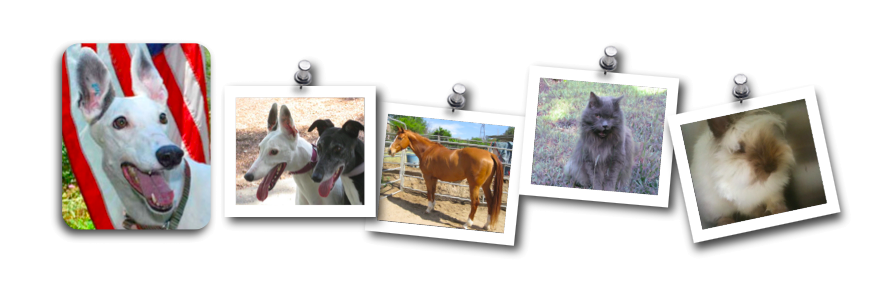The bunny I adopted has long nails, and I need to trim them. I expect he'll try to bite me; so I am procrastinating. This video came across my site: a technition demonstrates how to trim bunnies' nails. I hope it is helpful!
http://www.youtube.com/watch?v=F2CdhIsp7uM
By sharing our concerns and successes, we all benefit.
Animals live to serve us one way or another, so knowing how to take care of them is critical for our mutual well being.
Tuesday, June 15, 2010
Equine stress control therapy STEPS CAN BE LEARNED
This article gave me ideas which will enable me to better handle a stressful situation with a horse. I hope it inspires you. Nancy
First and foremost, the human needs to be centered and calm. Your self-control and calm breathing can do wonders to help the horse. He will take his cue from the environment and your behavior is part of that. If a vet is on-site, all the better. Every effort needs to be made to keep the horse comfortable. Horses who have been sedated are NOT candidates for ESCT as tranquilizers of any type will interfere with the ESCT process.
Minimum requirements for the process to work are that the horse is able to stand and be handled with a halter and lead rope. It is best to work with an assistant in an emergency situation if at all possible. Moving the horse to a quiet place away from the fracas is also recommended, as working in a whirlwind situation is counter-productive.
Note that there is a definite protocol involved in healing a horse with ESCT. [The complete protocol is described in the Book of Horse Healing Secrets and in the ESCT and Pulser videos and DVDs available through www.harmonyhorseworks.com] It is likely that your state’s animal control network gives clinics in animal disaster relief. Many vets are trained in animal disaster management techniques. Adding ESCT to help horses in trauma situations is very effective. This is another welcome tool to help animals in need during tough situations. We recommend becoming completely familiar with the protocol and using it on many horses before heading out into a trauma situation.
Barbara Wright operates Harmony HorseWorks, Horse Sanctuary and Rescue in Conifer, CO. Contact her at (303) 816-0766, barbara@harmonyhorseworks.comThis e-mail address is being protected from spambots. You need JavaScript enabled to view it , harmonyhorsewrks@aol.comThis e-mail address is being protected from spambots. You need JavaScript enabled to view it or visit www.harmonyhorseworks.com
First and foremost, the human needs to be centered and calm. Your self-control and calm breathing can do wonders to help the horse. He will take his cue from the environment and your behavior is part of that. If a vet is on-site, all the better. Every effort needs to be made to keep the horse comfortable. Horses who have been sedated are NOT candidates for ESCT as tranquilizers of any type will interfere with the ESCT process.
Minimum requirements for the process to work are that the horse is able to stand and be handled with a halter and lead rope. It is best to work with an assistant in an emergency situation if at all possible. Moving the horse to a quiet place away from the fracas is also recommended, as working in a whirlwind situation is counter-productive.
Note that there is a definite protocol involved in healing a horse with ESCT. [The complete protocol is described in the Book of Horse Healing Secrets and in the ESCT and Pulser videos and DVDs available through www.harmonyhorseworks.com] It is likely that your state’s animal control network gives clinics in animal disaster relief. Many vets are trained in animal disaster management techniques. Adding ESCT to help horses in trauma situations is very effective. This is another welcome tool to help animals in need during tough situations. We recommend becoming completely familiar with the protocol and using it on many horses before heading out into a trauma situation.
Barbara Wright operates Harmony HorseWorks, Horse Sanctuary and Rescue in Conifer, CO. Contact her at (303) 816-0766, barbara@harmonyhorseworks.comThis e-mail address is being protected from spambots. You need JavaScript enabled to view it , harmonyhorsewrks@aol.comThis e-mail address is being protected from spambots. You need JavaScript enabled to view it or visit www.harmonyhorseworks.com
Reprogramming a stressful situation for a horse: REPLACE THE TRAUMATIC MEMORY for the horse
According to Barbara Wright:
Equine Stress Control Therapy (ESCT) deals directly with the horse's brain through the optic nerve and skeletal structure, sending interrupt signals to it while it re-lives and then re-thinks its traumatic experience in a controlled setting. As a result, reprocessing of the harmful memory happens quickly and the horse is liberated of its fear. Horses can return to their original fear within the situation and environment created by the ESCT therapist to re-establish as close a situation to the original as possible, and then discharge the energy associated with that fear. What is left in the horse's realm of experience is a new baseline of comfort stemming from having overcome the fear and having survived it.
The new experience creates a new memory with a new positive energetic charge and the old memory is removed.
Horses want to be healthy and whole. Being a healthy member of the herd is a biological imperative so the push to healing is great. A partnership with a human is also considered a herd bond, and the same push to healing and well-being in the horse applies in its relations with humans.
Equine stress management
Labels:
uin
Subscribe to:
Comments (Atom)
